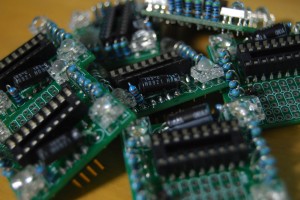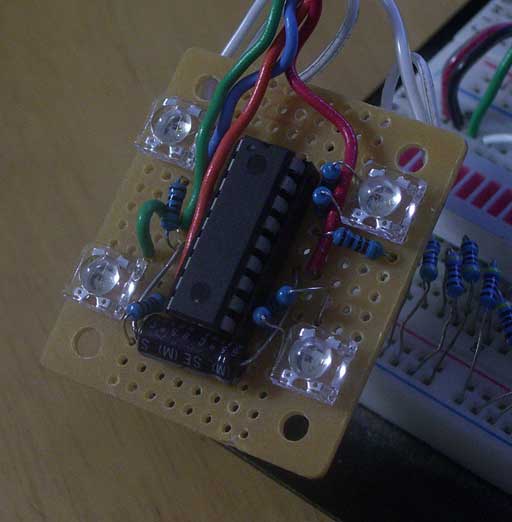So, this project was sidelined until I had to make another BatchPCB purchase. Thankfully it wasn’t too long until I had the opportunity to work on it again! The current setup is basically 4 of the original 4 RGB LED Controller boards and 12 of the updated DR1r3 boards. All 16 are wired in parallel and being controlled by my desktop machine. You can see an extended version of this RGB test sequence after the break and I’m also including the (uncommented, sorry!) Processing 1.1 code that I used to control the boards.
Category: PIC16F628
4 RGB LED Controller Update
I recently began working on a consulting project that required the creation of some PCBs. Since I have had such great success with BatchPCB.com in the past, I decided to use them again to fab the custom PCBs. The BatchPCB purchasing system adds a few static fees (set-up, handling, and shipping), so I felt that this was as good a time as any to make some additional of my PIC16F628 4 RGB LED PWM Controller boards with a couple of modifications.
PIC16F628 Serial 4 LED PWM DR1r6
I’ve been working on a project in my spare time with two friends to create some ambient light controllers, so I thought I’d just post two short videos to demonstrate the current state of the project. In the current iteration, they can be used as wall-washers or they can be enclosed to create ambient light cubes/spheres/pentagonal cupolas/rhombo-hexagonal dodecahedrons/etc. Each module is addressable and uses a PIC16F628 to control each of the RGB LEDs (which were purchased from the eBay seller jeledhk with the description “Superflux RGB 5mm R/H LEDLamp 8Kmcd COMMON CATHODE”). The PCBs were created using BatchPCB.com for $5 each (+ ~$15 total for S&H and setup) and are beautifully etched, drilled, and silkscreened (although it took about 1.5 months to receive them). Ok, less talk, more videos; one video on the front page and another after the jump:
PIC16F628 Serial 4 LED PWM
It has been a long time since I’ve done any microcontroller work, so I decided to get back into the swing of things when 2 of my friends and I decided on collaborating on an interactive “art” piece. Details are forthcoming, but in the meantime, a photo and a video of one of the LED components (video after the break):
PIC16F628 Serial 8 RGB LED Controller
 This code is for a simple RGB LED controller for 8 LEDs using a PIC16F628. It is controlled by sending 3 bytes to the internal USART for the red, green, and blue color channels. The operation is very simple and so is the wiring. The PIC selects each LED then turns on/off the respective colors then goes to the next LED. Because of persistence of vision, the eye sees the LEDs as all being on at the same time.
This code is for a simple RGB LED controller for 8 LEDs using a PIC16F628. It is controlled by sending 3 bytes to the internal USART for the red, green, and blue color channels. The operation is very simple and so is the wiring. The PIC selects each LED then turns on/off the respective colors then goes to the next LED. Because of persistence of vision, the eye sees the LEDs as all being on at the same time.
PIC16F628 8 RGB LED Controller
 This code is for a simple RGB LED controller for 8 LEDs using a PIC16F628. The pattern is determined by the data in the EEPROM. Upon startup, the controller loads the data into RAM and starts up the sequence. The operation is very simple and so is the wiring. The PIC selects each LED then turns on/off the respective colors then goes to the next LED. Because of persistence of vision, the eye sees the LEDs as all being on at the same time. Currently the max number of display patterns is 20 (because the bank array is 80 bytes and each pattern is 4 bytes).
This code is for a simple RGB LED controller for 8 LEDs using a PIC16F628. The pattern is determined by the data in the EEPROM. Upon startup, the controller loads the data into RAM and starts up the sequence. The operation is very simple and so is the wiring. The PIC selects each LED then turns on/off the respective colors then goes to the next LED. Because of persistence of vision, the eye sees the LEDs as all being on at the same time. Currently the max number of display patterns is 20 (because the bank array is 80 bytes and each pattern is 4 bytes).
PIC16F628 Serial 1 RGB LED PWM Controller
 This code is for a simple RGB LED controller for 1 LED using a PIC16F628 that has PWM control for the LED. It is controlled by sending 2 bytes to the PIC’s internal USART for the intensities of the red, green, and blue color channels. The operation is very simple and so is the wiring. The PIC loops and turns on the respective colors if they are less than or equal to theCount. Because of persistence of vision, the eye sees the LEDs as all being on at the same time. The 4-bit code below has 15 linear values of PWM. The 8-bit code has 255 linear values of PWM. The 4-bit exponential PWM code has 15 values fit to an exponential curve. This allows for more “even” color levels because the human eye does not readily perceive linear changes in light intensity. For LED applications, the 4-bit exponential code is recommended.
This code is for a simple RGB LED controller for 1 LED using a PIC16F628 that has PWM control for the LED. It is controlled by sending 2 bytes to the PIC’s internal USART for the intensities of the red, green, and blue color channels. The operation is very simple and so is the wiring. The PIC loops and turns on the respective colors if they are less than or equal to theCount. Because of persistence of vision, the eye sees the LEDs as all being on at the same time. The 4-bit code below has 15 linear values of PWM. The 8-bit code has 255 linear values of PWM. The 4-bit exponential PWM code has 15 values fit to an exponential curve. This allows for more “even” color levels because the human eye does not readily perceive linear changes in light intensity. For LED applications, the 4-bit exponential code is recommended.
PIC16F628 Serial 8 RGB LED PWM Controller
 This code is for a simple RGB LED controller for 8 LEDs using a PIC16F628 that has PWM control for the LEDs. It is controlled by sending 12 bytes to the PIC’s internal USART for the intensities of the red, green, and blue color channels. The operation is very simple and so is the wiring. The PIC selects each LED and turns on the respective colors if they are less than or equal to theCount then goes to the next LED. Because of persistence of vision, the eye sees the LEDs as all being on at the same time. However, because this is running off the internal OSC (4MHz) and the code is not optimized, there is some flickering evident when moving one’s head from side to side.
This code is for a simple RGB LED controller for 8 LEDs using a PIC16F628 that has PWM control for the LEDs. It is controlled by sending 12 bytes to the PIC’s internal USART for the intensities of the red, green, and blue color channels. The operation is very simple and so is the wiring. The PIC selects each LED and turns on the respective colors if they are less than or equal to theCount then goes to the next LED. Because of persistence of vision, the eye sees the LEDs as all being on at the same time. However, because this is running off the internal OSC (4MHz) and the code is not optimized, there is some flickering evident when moving one’s head from side to side.

